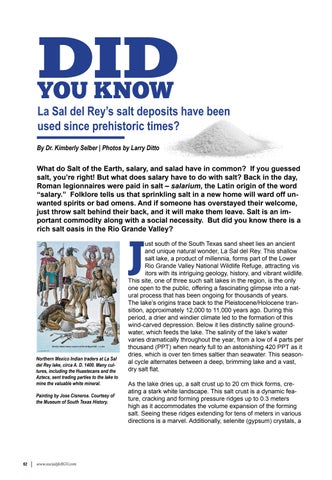DID YOU KNOW
La Sal del Rey’s salt deposits have been used since prehistoric times? By Dr. Kimberly Selber | Photos by Larry Ditto
What do Salt of the Earth, salary, and salad have in common? If you guessed salt, you’re right! But what does salary have to do with salt? Back in the day, Roman legionnaires were paid in salt – salarium, the Latin origin of the word “salary.” Folklore tells us that sprinkling salt in a new home will ward off unwanted spirits or bad omens. And if someone has overstayed their welcome, just throw salt behind their back, and it will make them leave. Salt is an important commodity along with a social necessity. But did you know there is a rich salt oasis in the Rio Grande Valley?
J
Northern Mexico Indian traders at La Sal del Rey lake, circa A. D. 1400. Many cultures, including the Huastecans and the Aztecs, sent trading parties to the lake to mine the valuable white mineral. Painting by Jose Cisneros. Courtesy of the Museum of South Texas History.
62
www.socialifeRGV.com
ust south of the South Texas sand sheet lies an ancient and unique natural wonder, La Sal del Rey. This shallow salt lake, a product of millennia, forms part of the Lower Rio Grande Valley National Wildlife Refuge, attracting vis itors with its intriguing geology, history, and vibrant wildlife. This site, one of three such salt lakes in the region, is the only one open to the public, offering a fascinating glimpse into a natural process that has been ongoing for thousands of years. The lake’s origins trace back to the Pleistocene/Holocene transition, approximately 12,000 to 11,000 years ago. During this period, a drier and windier climate led to the formation of this wind-carved depression. Below it lies distinctly saline groundwater, which feeds the lake. The salinity of the lake’s water varies dramatically throughout the year, from a low of 4 parts per thousand (PPT) when nearly full to an astonishing 420 PPT as it dries, which is over ten times saltier than seawater. This seasonal cycle alternates between a deep, brimming lake and a vast, dry salt flat. As the lake dries up, a salt crust up to 20 cm thick forms, creating a stark white landscape. This salt crust is a dynamic feature, cracking and forming pressure ridges up to 0.3 meters high as it accommodates the volume expansion of the forming salt. Seeing these ridges extending for tens of meters in various directions is a marvel. Additionally, selenite (gypsum) crystals, a
